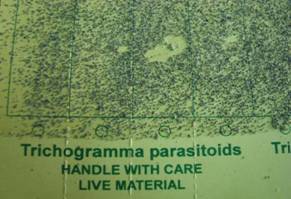| Mass production of Trichogramma sp. |
|
Introduction
- The genus Trichogramma is cosmopolitan in distribution and present in all terrestrial habitats and is one of 80 genera in the family Trichogrammatidae. Trichogramma are primary parasitoids eggs of Lepidoptera, but parasitism also occurs in eggs of other orders such as Coleoptera, Diptera, Hemiptera, Hymenoptera and Neuroptera.
- It is important for plant protection because of its wide spread natural occurrence and its success as biological control agent by mass releasing.
- Since this parasitoid kills the pest in the egg stage itself before the pest could cause any damage to the crop and also that it is quite amenable to mass production in the laboratories, it has the distinction of being the highest produced and most utilized biological control agent in the world Trichogrammatidae includes the smallest of insects, ranging in size from 0.2 to 1.5 mm.
- Trichogramma are difficult to identify because they are so small and have generally uniform morphological characters. Also, certain physical characteristics such as body color and the number and length of body hairs can vary with body size, season, rearing temperature and the host on which the adult was reared.
- A major advance in the systematics of Trichogramma was the discovery that characteristics of male genitalia can be used to identify species. This is the primary means of identification today, but body color, wing venation and features of the antennae serve as supporting characteristics.
- Females cannot be identified with the same level of confidence, so collections submitted for identification must include males in addition to physical characteristics; studies of reproductive compatibility and mode of reproduction also have been especially valuable in identifying species.
Biology of Trichogramma
- The development of all Trichogramma spp. is very similar. Being an egg parasite, the female drills a hole through the chorion and deposits its eggs within the egg of the host.
- The internal pressure of the egg forces a small drop of yolk out of the oviposition hole. Females feed on this yolk, which increases their longevity and under laboratory conditions a female parasitizes from one to ten eggs per day or from ten to 190 during her life.
- Large females parasitize more eggs than smaller females. The number of eggs laid per host egg may vary from 1 to 20 or more depending upon the size of the host egg. However in sugarcane, in which moth borer eggs are small, generally 1 or 2 parasites develop per egg.
- A female parasitoid can distinguish already parasitised eggs, thereby avoiding superparasitism or multiple-parasitism under natural conditions. Fecundity varies from 20 to 200 eggs per female according to the species, the host, and the longevity of the adult.
- Eggs in the early stages of development are more suitable for parasite development. Older eggs, especially those in which the head capsule of the larva is visible, are not usually parasitized and if they are, parasite survival is much lower. Venom injected by the female at the time of oviposition is believed to cause this predigestion of the egg’s contents.
- During the 3rd instar (3 to 4 days after the host egg was parasitized) dark melanin granules are deposited on the inner surface of the egg chorion, causing the host egg to turn black. This is an invaluable diagnostic character for distinguishing them from unparasitised eggs. Larvae then transform to the inactive pupal stage.
- The adult wasps emerge from the pupae and escape the host egg by chewing a circular hole in the egg shell. The black layer inside the chorion and the exit hole are evidence of parasitism by Trichogramma. The egg, larval and pupal stages of Trichogramma at 28 ± 20C are completed in about 1 day, 3 to 4 days, and 4 to 5 days respectively.
- Thus, the life cycle is completed in 8 to 10 days, but it may be prolonged at lower temperatures or hampered at very high temperatures. The adults are short lived (6-8 days). Mating and oviposition take place immediately after emergence. The sex ratio is generally 1:1.
 |
 |
| Tricho card |
|
|

